Identifying Urban Traveling Hotspots Using an Interaction-Based Spatio-Temporal Data Field and Trajectory Data: A Case Study within the Sixth Ring Road of Beijing
Abstract
1. Introduction
2. Data Field Theory and Its Classical Expansions
3. Methodology
3.1. Interaction-Based Spatio-Temporal Data Field (STDF) Identification for Urban Hotspots
3.1.1. Calculation of Potential Value
3.1.2. Quantifying the Potential Value of the Study Unit
3.1.3. Determining the Urban Hotspots by Edge Detection
3.2. Evaluating the Proposed Methods
3.2.1. Basic Validation
3.2.2. Quantifying the Accuracy of Identification
4. Case Study
4.1. Study Area and Dataset
4.2. Spatio-Temporal Patterns of Urban Travelling Hotspots
4.2.1. Dynamic Characteristics of Hotspots on Weekdays
4.2.2. Dynamic Characteristics of Hotspots on Weekends
4.3. Evaluation of Accuracy
5. Discussion
6. Conclusions
Author Contributions
Funding
Acknowledgments
Conflicts of Interest
Appendix A
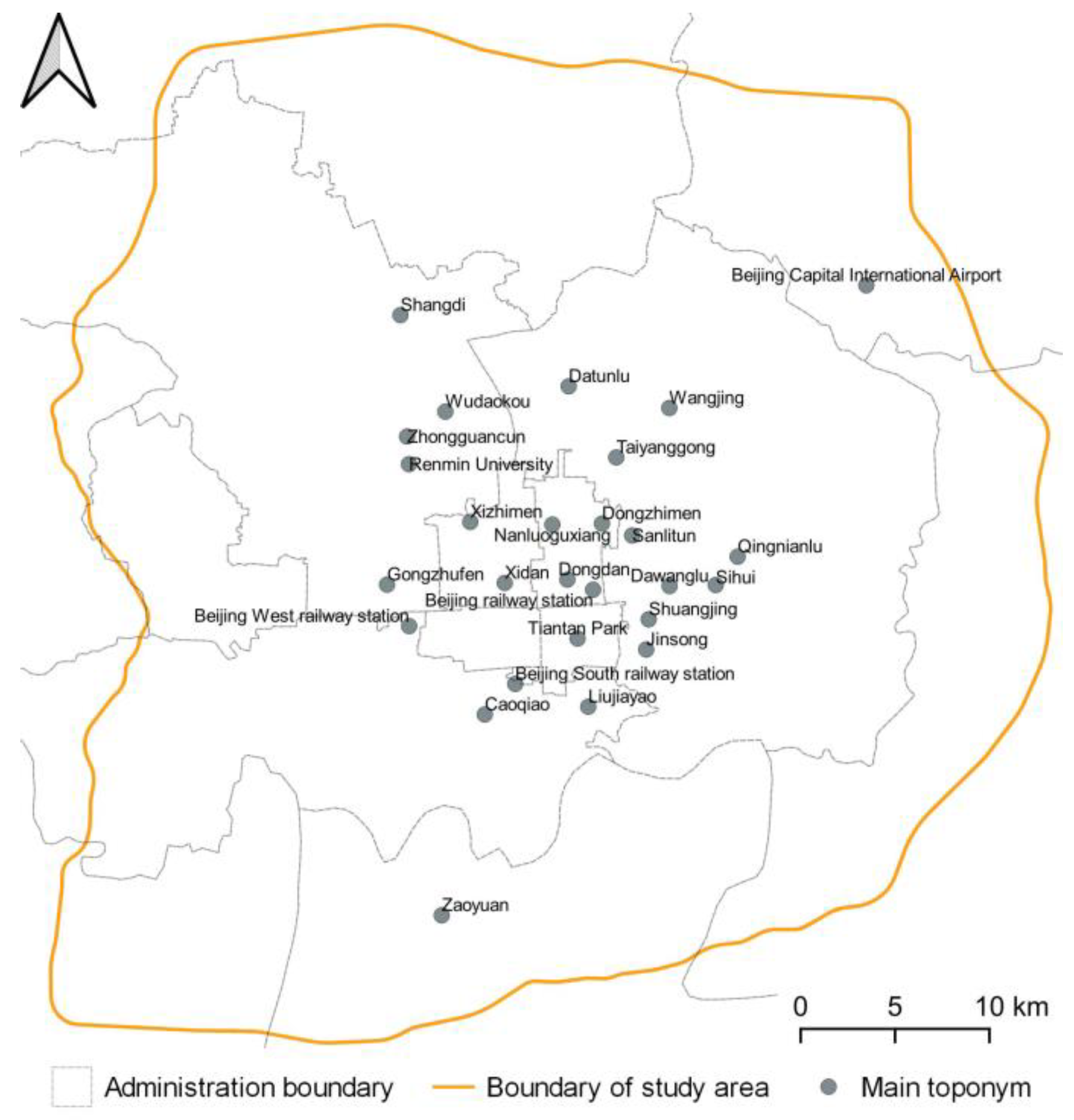
References
- Li, S.; Ma, Y. Urbanization, economic development and environmental change. Sustainability 2014, 6, 5143–5161. [Google Scholar] [CrossRef]
- Yang, X.; Zhao, Z.; Lu, S. Exploring spatio-temporal patterns of urban human mobility hotspots. Sustainability 2016, 8, 674. [Google Scholar] [CrossRef]
- Qin, K.; Xu, Y.; Kang, C.; Sobolevsky, S.; Kwan, M.-P. Modeling spatio-temporal evolution of urban crowd flows. ISPRS Int. Geo-Inf. 2019, 8, 570. [Google Scholar] [CrossRef]
- Crampton, J.W.; Graham, M.; Poorthuis, A.; Shelton, T.; Stephens, M.; Wilson, M.W.; Zook, M. Beyond the geotag: Situating “Big Data” and leveraging the potential of the geoweb. Cartogr. Geogr. Inf. Sci. 2013, 40, 130–139. [Google Scholar] [CrossRef]
- Liu, Y.; Liu, X.; Gao, S.; Gong, L.; Kang, C.; Zhi, Y.; Shi, L. Social sensing: A new approach to understanding our socioeconomic environments. Ann. Assoc. Am. Geogr. 2015, 105, 512–530. [Google Scholar] [CrossRef]
- Schneider, C.M.; Belik, V.; Couronné, T.; Smoreda, Z.; González, M.C. Unravelling daily human mobility motifs. J. R. Soc. Interface 2013, 10, 20130246. [Google Scholar] [CrossRef]
- Pappalardo, L.; Simini, F.; Rinzivillo, S.; Pedreschi, D.; Giannotti, F.; Barabási, A.-L. Returners and explorers dichotomy in human mobility. Nat. Commun. 2015, 6, 8166. [Google Scholar] [CrossRef]
- Yan, X.Y.; Wang, W.X.; Gao, Z.Y.; Lai, Y.-C. Universal model of individual and population mobility on diverse spatial scales. Nat. Commun. 2017, 8, 1639. [Google Scholar] [CrossRef]
- Pappalardo, L.; Simini, F. Data-driven generation of spatio-temporal routines in human mobility. Data Min. Knowl. Discov. 2018, 32, 787–829. [Google Scholar] [CrossRef]
- Yang, C.; Yan, F.; Ukkusuri, S.V. Unraveling traveler mobility patterns and predicting user behavior in the Shenzhen metro system. Transportmetrica 2018, 14, 576–597. [Google Scholar] [CrossRef]
- Chen, P.; Shi, W.; Zhou, X.; Liu, Z.; Fu, X. STLP-GSM: A method to predict future locations of individuals based on geotagged social media data. Int. J. Geogr. Inf. Sci. 2019, 33, 2337–2362. [Google Scholar] [CrossRef]
- Yao, X.; Zhu, D.; Gao, Y.; Wu, L.; Zhang, P.; Liu, Y. A stepwise spatio-temporal flow clustering method for discovering mobility trends. IEEE Access 2018, 6, 44666–44675. [Google Scholar] [CrossRef]
- Tao, R.; Thill, J.-C. Flow cross K-function: A bivariate flow analytical method. Int. J. Geogr. Inf. Sci. 2019, 33, 2055–2071. [Google Scholar] [CrossRef]
- Zhu, D.; Huang, Z.; Shi, L.; Wu, L.; Liu, Y. Inferring spatial interaction patterns from sequential snapshots of spatial distributions. Int. J. Geogr. Inf. Sci. 2018, 32, 783–805. [Google Scholar] [CrossRef]
- Xu, Y.; Belyi, A.; Bojic, I.; Ratti, C. Human mobility and socioeconomic status: Analysis of Singapore and Boston. Comput. Environ. Urban Syst. 2018, 72, 51–67. [Google Scholar] [CrossRef]
- Tang, J.; Gao, F.; Liu, F.; Zhang, W.; Qi, Y. Understanding spatio-temporal characteristics of urban travel demand based on the combination of GWR and GLM. Sustainability 2019, 11, 5525. [Google Scholar] [CrossRef]
- Yang, J.; Yi, D.; Qiao, B.; Zhang, J. Spatio-temporal change characteristics of spatial-interaction networks: Case study within the sixth ring road of Beijing, China. ISPRS Int. Geo-Inf. 2019, 8, 273. [Google Scholar] [CrossRef]
- Yang, J.; Yi, D.; Liu, J.; Liu, Y.; Zhang, J. Spatiotemporal change characteristics of nodes’ heterogeneity in the directed and weighted spatial interaction networks: Case study within the sixth ring road of Beijing, China. Sustainability 2019, 11, 6359. [Google Scholar] [CrossRef]
- Zhao, P.; Qin, K.; Ye, X.; Wang, Y.; Chen, Y. A trajectory clustering approach based on decision graph and data field for detecting hotspots. Int. J. Geogr. Inf. Sci. 2017, 31, 1101–1127. [Google Scholar] [CrossRef]
- Xia, Z.; Li, H.; Chen, Y.; Liao, W. Identify and delimitate urban hotspot areas using a network-based spatiotemporal field clustering method. ISPRS Int. Geo-Inf. 2019, 8, 344. [Google Scholar] [CrossRef]
- Anselin, L. Local indicators of spatial association—LISA. Geogr. Anal. 2010, 27, 93–115. [Google Scholar] [CrossRef]
- Getis, A. The analysis of spatial association by use of distance statistics. Geogr. Anal. 2010, 24, 189–206. [Google Scholar] [CrossRef]
- Reinau, K.H. Emerging hot spot analysis: Estimating the development in the speed of freight in a region using tracking data from logistics companies. In Proceedings of the Association of American Geographers Annual Meeting, Boston, MA, USA, 5–9 April 2017. [Google Scholar]
- Harris, N.L.; Goldman, E.; Gabris, C.; Nordling, J.; Minnemeyer, S.; Ansari, S.; Hansen, M. Using spatial statistics to identify emerging hot spots of forest loss. Environ. Res. Lett. 2017, 12, 24012. [Google Scholar] [CrossRef]
- Usman, M.; Sitanggang, I.S.; Syaufina, L. Hotspot distribution analyses based on peat characteristics using density-based spatial clustering. Procedia. Environ. Sci. 2015, 24, 132–140. [Google Scholar] [CrossRef][Green Version]
- Zhou, D.; Hong, R.; Xia, J. Identification of taxi pick-up and drop-off hotspots using the density-based spatial clustering method. In Proceedings of the CICTP 2017, Shanghai, China, 7–9 July 2017. [Google Scholar]
- Pei, T.; Wang, W.; Zhang, H.; Ma, T.; Du, Y.; Zhou, C. Density-based clustering for data containing two types of points. Int. J. Geogr. Inf. Sci. 2015, 29, 175–193. [Google Scholar] [CrossRef]
- Wang, T.; Ren, C.; Luo, Y.; Tian, J. NS-DBSCAN: A density-based clustering algorithm in network space. ISPRS Int. Geo-Inf. 2019, 8, 218. [Google Scholar] [CrossRef]
- Zhang, P.; Deng, M.; Shi, Y.; Zhao, L. Detecting hotspots of urban residents’ behaviours based on spatio-temporal clustering techniques. GeoJournal 2017, 82, 923–935. [Google Scholar] [CrossRef]
- Zhou, Y.; Fang, Z.; Thill, J.-C.; Li, Q.; Li, Y. Functionally critical locations in an urban transportation network: Identification and space–time analysis using taxi trajectories. Comput. Environ. Urban Syst. 2015, 52, 34–47. [Google Scholar] [CrossRef]
- Deng, M.; Yang, X.; Shi, Y.; Gong, J.; Liu, Y.; Liu, H. A density-based approach for detecting network-constrained clusters in spatial point events. Int. J. Geogr. Inf. Sci. 2019, 33, 466–488. [Google Scholar] [CrossRef]
- Li, D.; Du, Y. Artificial Intelligent with Uncertainty; Chapman and Hall, CRC: Boca Raton, FL, USA, 2007. [Google Scholar]
- Wang, S.; Gan, W.; Li, D.; Li, D. Data field for hierarchical clustering. Int. J. Data. Warehous. 2011, 7, 43–63. [Google Scholar] [CrossRef]
- Li, C.; Ding, G.; Wang, D.; Li, Y.; Wang, S. Clustering by fast search and find of density peaks with data field. Chin. J. Electron. 2016, 25, 397–402. [Google Scholar]
- Wu, T.; Qin, K. Image data field for homogeneous region based segmentation. Comput. Electr. Eng. 2012, 38, 459–470. [Google Scholar] [CrossRef]
- Qin, K.; Zhou, Q.; Wu, T.; Xu, Y.Q. Hotspots Detection from Trajectory Data Based on Spatiotemporal Data Field Clustering; ISPRS—International Archives of the Photogrammetry, Remote Sensing and Spatial Information Sciences: Wuhan, China, 2017. [Google Scholar]
- Chen, L.; Gao, Y.; Zhu, D.; Yuan, Y.; Liu, Y. Quantifying the scale effect in geospatial big data using semi-variograms. PLoS ONE 2019, 14, e0225139. [Google Scholar] [CrossRef]
- Openshaw, S. The Modifiable Areal Unit Problem. Concepts and Techniques in Modern Geography; Geo Books: Norwich, UK, 1984. [Google Scholar]
- Rosin, P. Unimodal thresholding. Pattern Recognit. 2001, 34, 2083–2096. [Google Scholar] [CrossRef]
- Chainey, S.; Tompson, L.; Uhlig, S. The utility of hotspot mapping for predicting spatial patterns of crime. Secur. J. 2008, 21, 4–28. [Google Scholar] [CrossRef]
- Adepeju, M.; Rosser, G.; Cheng, T. Novel evaluation metrics for sparse spatio-temporal point process hotspot predictions—A crime case study. Int. J. Geogr. Inf. Sci. 2016, 30, 2133–2154. [Google Scholar] [CrossRef]
- Yang, B.; Liu, L.; Lan, M.; Wang, Z.; Zhou, H.; Yu, H. A spatio-temporal method for crime prediction using historical crime data and transitional zones identified from nightlight imagery. Int. J. Geogr. Inf. Sci. 2020, 1740–1764. [Google Scholar] [CrossRef]
- Hu, Y.; Wang, F.; Guin, C.; Zhu, H. A spatio-temporal kernel density estimation framework for predictive crime hotspot mapping and evaluation. Appl. Geogr. 2018, 99, 89–97. [Google Scholar] [CrossRef]
- Wang, Y.; Gu, Y.; Dou, M.; Qiao, M. Using spatial semantics and interactions to identify urban functional regions. ISPRS Int. Geo-Inf. 2018, 7, 130. [Google Scholar] [CrossRef]
- Liu, X.; Gong, L.; Gong, Y.; Liu, Y. Revealing travel patterns and city structure with taxi trip data. J. Transp. Geogr. 2015, 43, 78–90. [Google Scholar] [CrossRef]
- Zhong, C.; Arisona, S.M.; Huang, X.; Batty, M.; Schmitt, G. Detecting the dynamics of urban structure through spatial network analysis. Int. J. Geogr. Inf. Sci. 2014, 28, 2178–2199. [Google Scholar] [CrossRef]
- Shanmukhappa, T.; Ho, I.W.-H.; Tse, C.K. Spatial analysis of bus transport networks using network theory. Physica A 2018, 502, 295–314. [Google Scholar] [CrossRef]
- Wang, Y.; Deng, Y.; Ren, F.; Zhu, R.; Wang, P.; Du, T.; Du, Q. Analysing the spatial configuration of urban bus networks based on the geospatial network analysis method. Cities 2020, 96, 102406. [Google Scholar] [CrossRef]
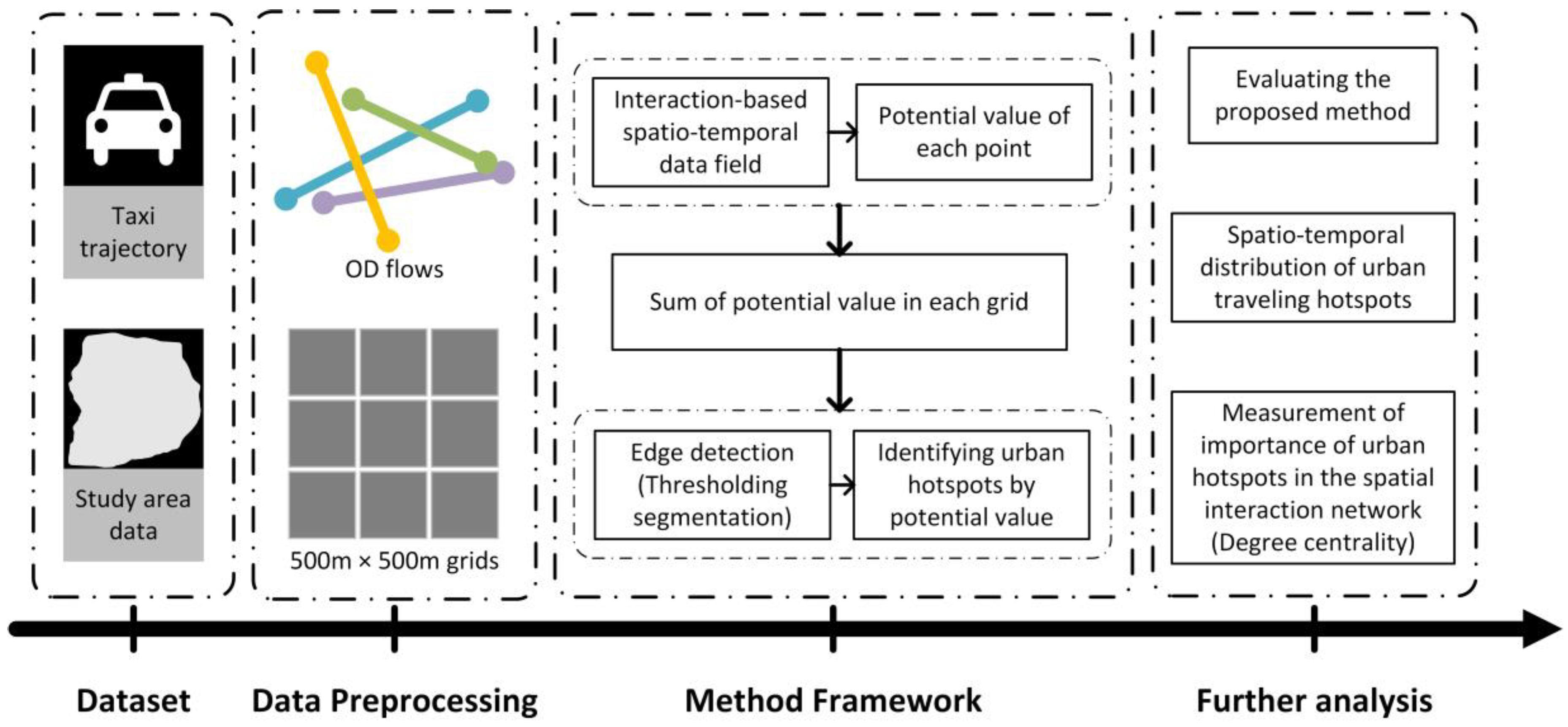
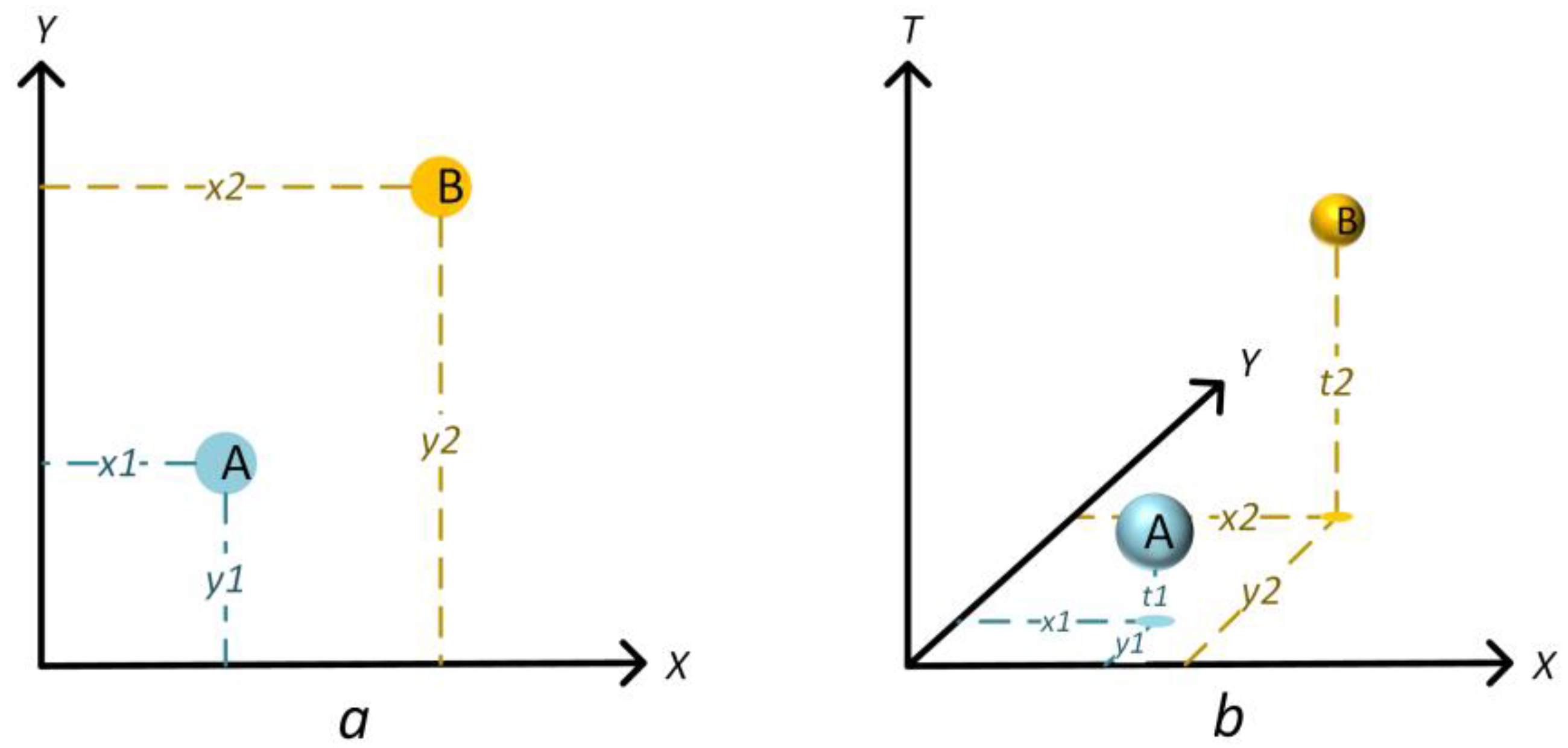

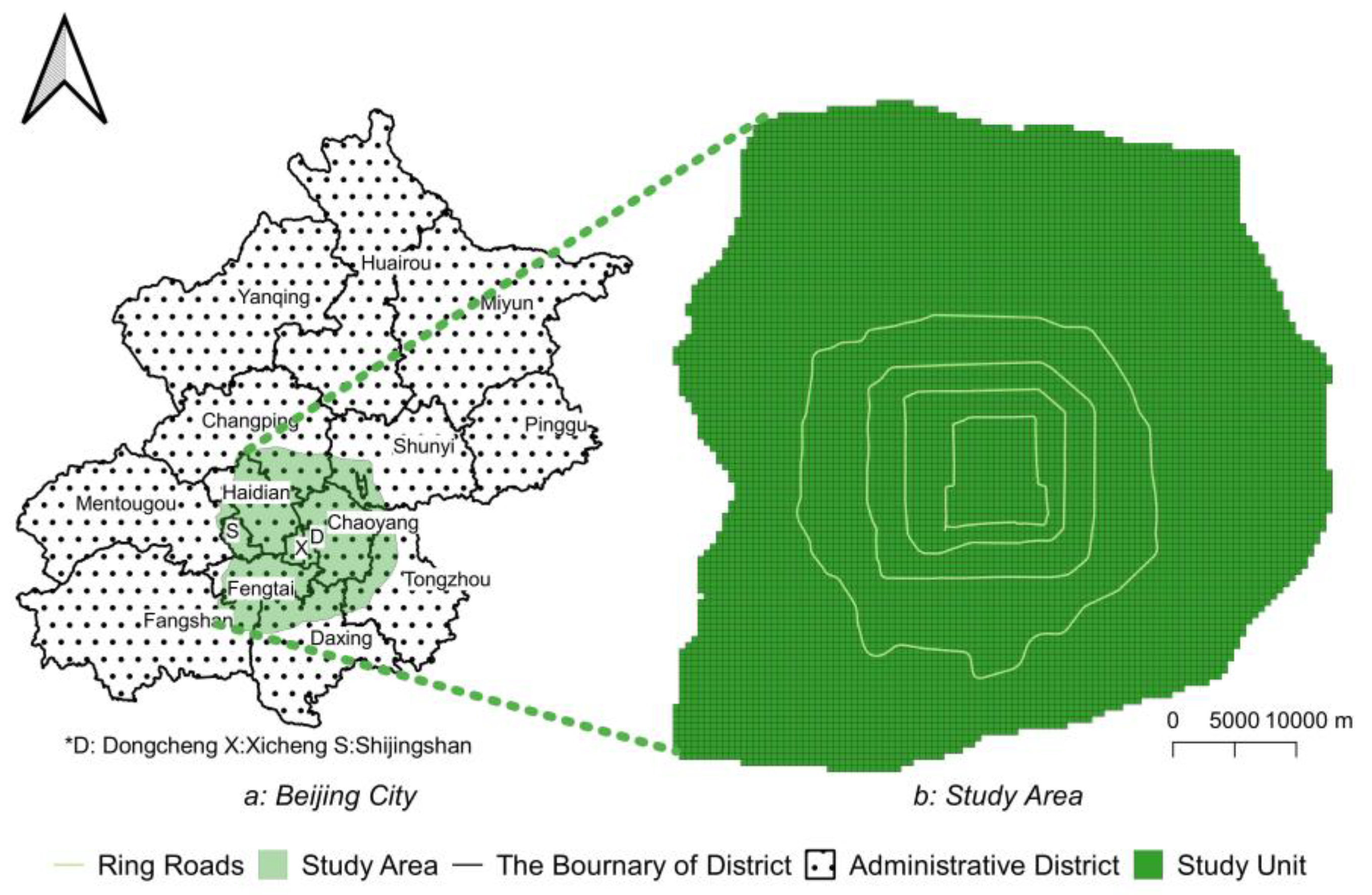

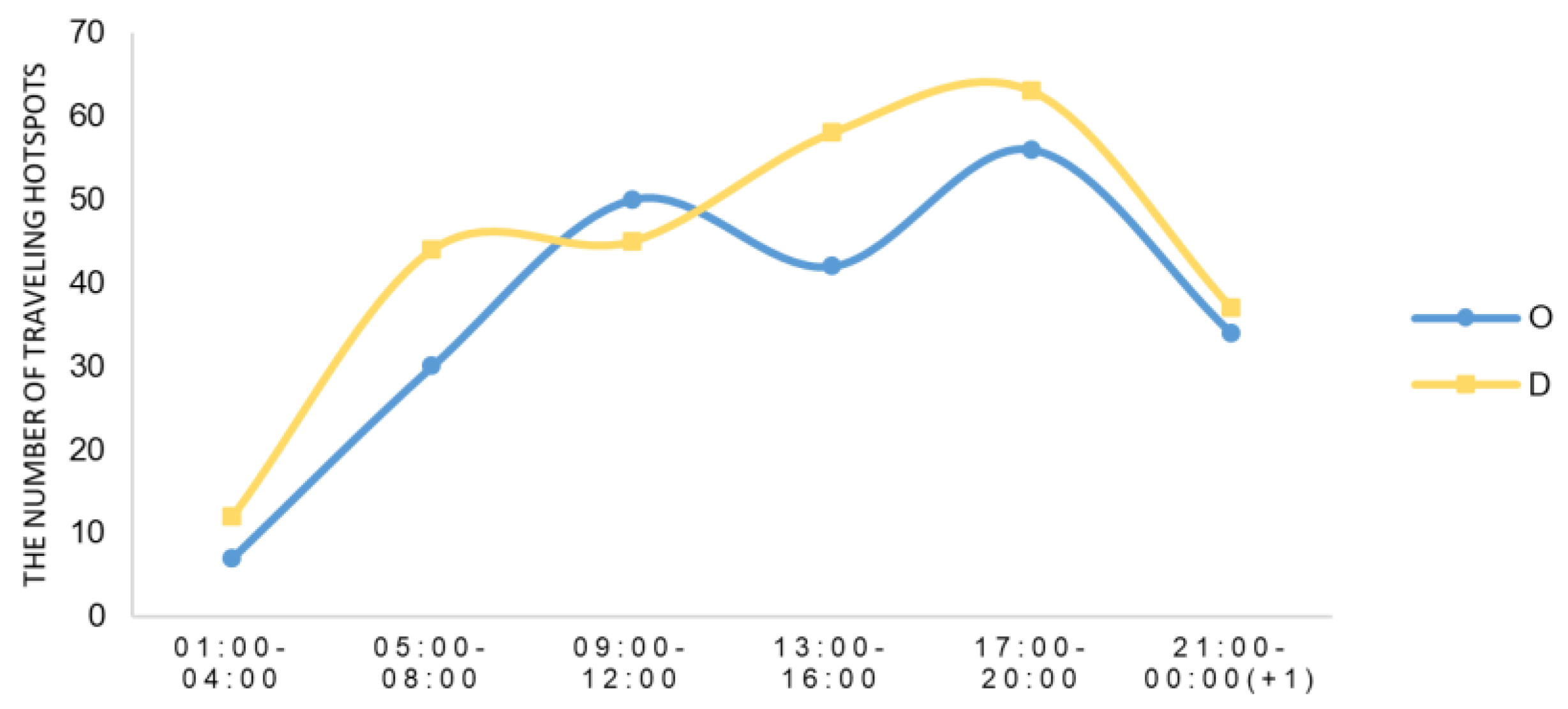

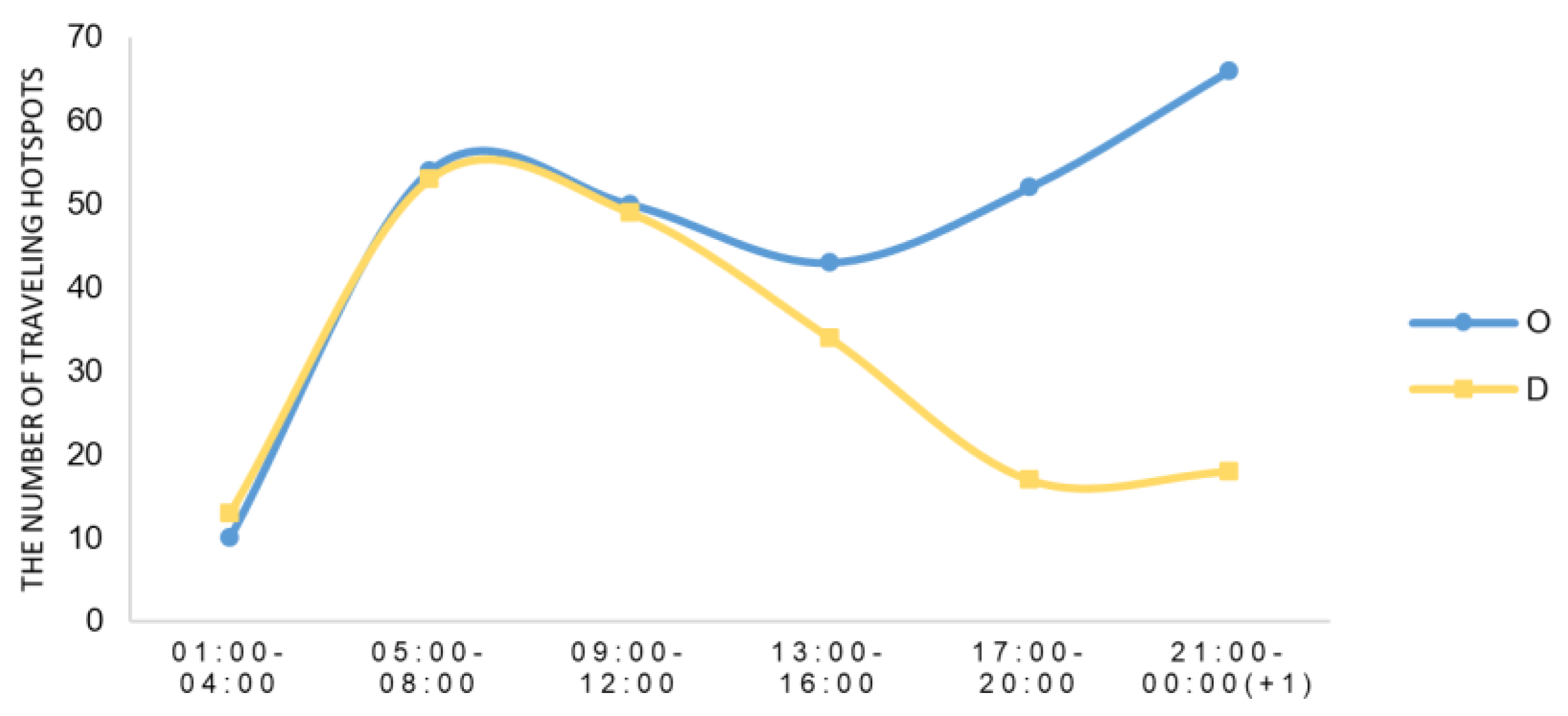
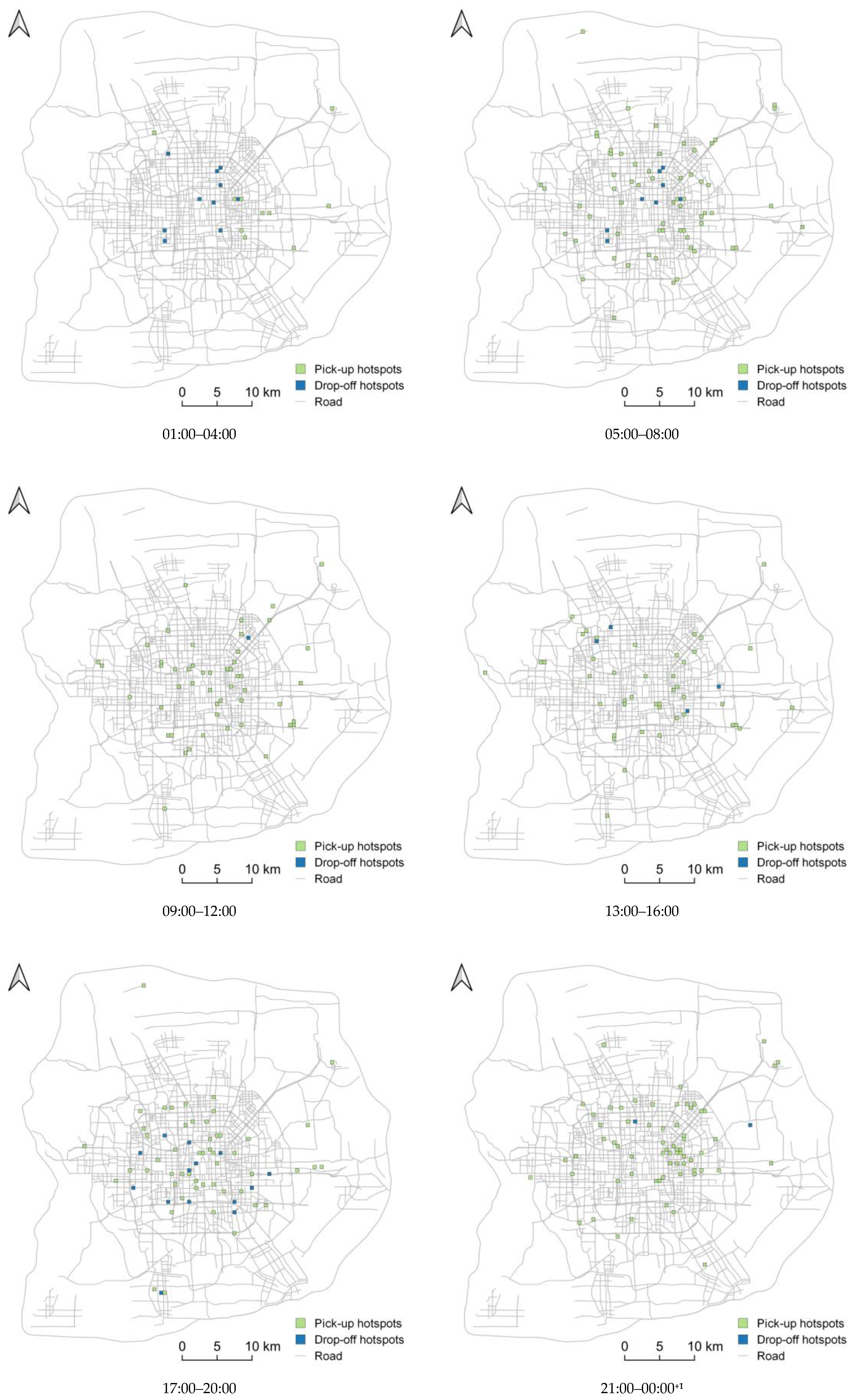
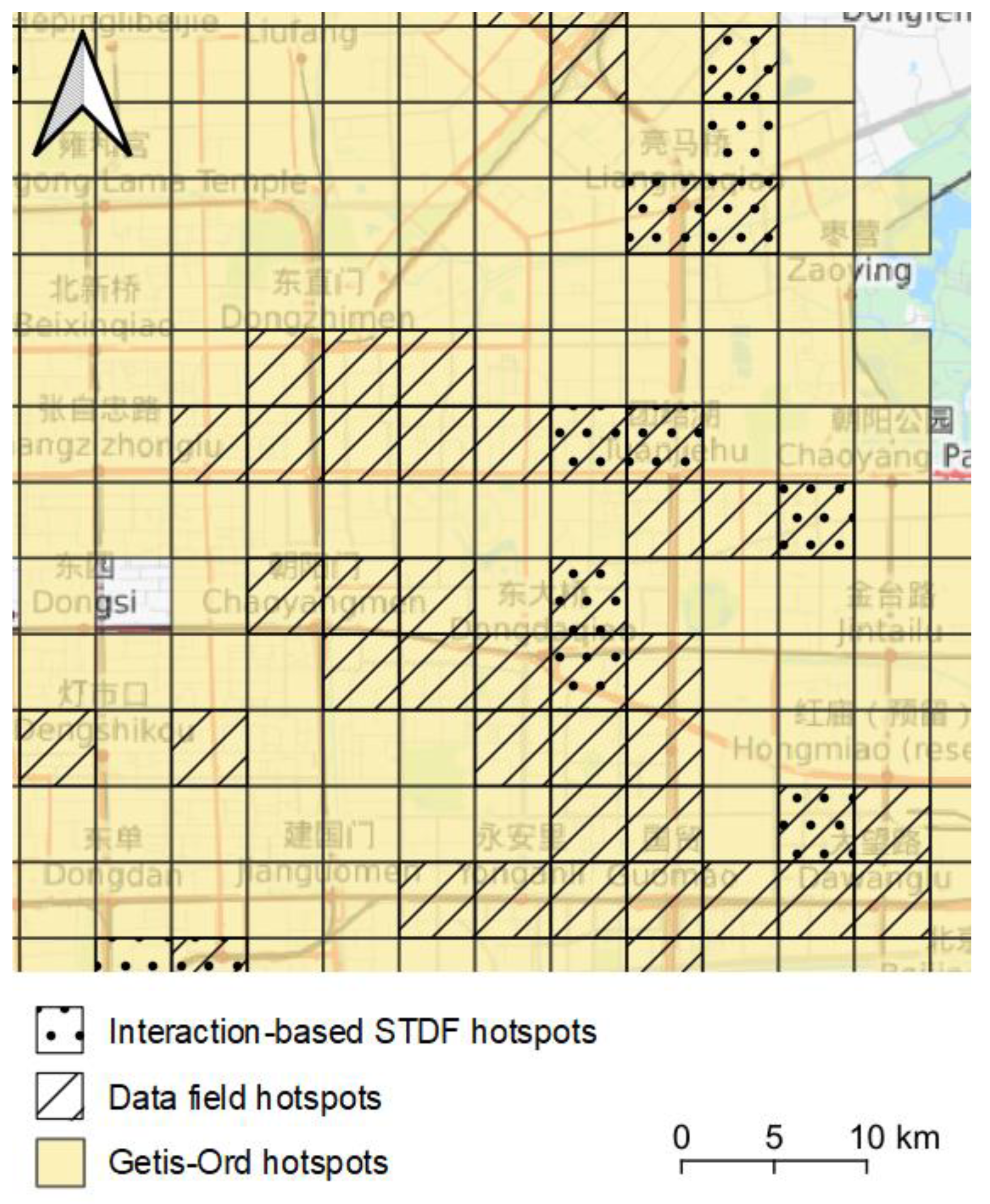


| Taxi ID | Pick-Up Time | Pick-Up Location | Drop-Off Time | Drop-Off Location |
|---|---|---|---|---|
| 1000 | 2016-6-10 10:37:44 | 116.58874, 40.07905 | 2016-6-10 11:5:1 | 116.39498, 39.99156 |
| 12179 | 2016-6-12 14:33:52 | 116.39114, 39.85552 | 2016-6-12 14:50:22 | 116.31633, 39.89542 |
| 1970 | 2016-6-14 20:58:35 | 116.55133, 40.06325 | 2016-6-14 21:7:54 | 116.47403, 40.01265 |
| Weekdays/Weekends | Method | 01:00–04:00 | 05:00–08:00 | 09:00–12:00 | 13:00–16:00 | 17:00–20:00 | 21:00–00:00+1 | Mean | |
|---|---|---|---|---|---|---|---|---|---|
| O | Weekdays | Getis-Ord Gi* | 3.680 | 3.423 | 3.737 | 3.816 | 3.815 | 3.608 | 3.680 |
| Data field | 12.270 | 10.003 | 9.598 | 9.174 | 6.811 | 6.018 | 8.979 | ||
| Interaction-based STDF | 24.682 | 8.252 | 8.377 | 9.929 | 8.228 | 8.857 | 11.388 | ||
| Weekends | Getis-Ord Gi* | 3.636 | 2.926 | 3.150 | 3.305 | 3.922 | 3.137 | 3.346 | |
| Data field | 7.438 | 4.802 | 6.156 | 6.856 | 5.108 | 5.139 | 5.917 | ||
| Interaction-based STDF | 10.089 | 7.787 | 8.105 | 8.159 | 14.935 | 6.498 | 9.262 | ||
| D | Weekdays | Getis-Ord Gi* | 3.669 | 3.413 | 3.624 | 3.951 | 3.815 | 3.485 | 3.660 |
| Data field | 8.454 | 10.313 | 8.686 | 8.895 | 6.587 | 5.846 | 8.130 | ||
| Interaction-based STDF | 10.565 | 11.623 | 8.952 | 7.983 | 7.420 | 6.301 | 8.807 | ||
| Weekends | Getis-Ord Gi* | 3.572 | 3.057 | 3.263 | 3.412 | 3.895 | 3.153 | 3.392 | |
| Data field | 10.150 | 4.703 | 5.863 | 7.088 | 5.599 | 5.858 | 6.544 | ||
| Interaction-based STDF | 6.604 | 8.422 | 8.139 | 8.402 | 12.761 | 5.864 | 8.365 |
Publisher’s Note: MDPI stays neutral with regard to jurisdictional claims in published maps and institutional affiliations. |
© 2020 by the authors. Licensee MDPI, Basel, Switzerland. This article is an open access article distributed under the terms and conditions of the Creative Commons Attribution (CC BY) license (http://creativecommons.org/licenses/by/4.0/).
Share and Cite
Yi, D.; Liu, Y.; Qin, J.; Zhang, J. Identifying Urban Traveling Hotspots Using an Interaction-Based Spatio-Temporal Data Field and Trajectory Data: A Case Study within the Sixth Ring Road of Beijing. Sustainability 2020, 12, 9662. https://doi.org/10.3390/su12229662
Yi D, Liu Y, Qin J, Zhang J. Identifying Urban Traveling Hotspots Using an Interaction-Based Spatio-Temporal Data Field and Trajectory Data: A Case Study within the Sixth Ring Road of Beijing. Sustainability. 2020; 12(22):9662. https://doi.org/10.3390/su12229662
Chicago/Turabian StyleYi, Disheng, Yusi Liu, Jiahui Qin, and Jing Zhang. 2020. "Identifying Urban Traveling Hotspots Using an Interaction-Based Spatio-Temporal Data Field and Trajectory Data: A Case Study within the Sixth Ring Road of Beijing" Sustainability 12, no. 22: 9662. https://doi.org/10.3390/su12229662
APA StyleYi, D., Liu, Y., Qin, J., & Zhang, J. (2020). Identifying Urban Traveling Hotspots Using an Interaction-Based Spatio-Temporal Data Field and Trajectory Data: A Case Study within the Sixth Ring Road of Beijing. Sustainability, 12(22), 9662. https://doi.org/10.3390/su12229662





